Projecting Future Change in Growing Degree Days for Winter Wheat
Abstract
:1. Introduction
2. Materials and Methods
3. Results
3.1. Historical Period
Bias Correction
3.2. Future Period (2006–2098)
RCP 4.5 and RCP 8.5
3.3. Mean Differences Between Past and Future Periods
4. Conclusions and Discussion
Supplementary Material
- 1/10th of a degree observation based dataset.DOI: 10.15763/DBS.SCCSC.RR.0001
- Downscaled climate variables from the CCSM4 GCM.DOI: 10.15763/DBS.SCCSC.RR.0002
- Downscaled climate variables from MIROC5 GCM.DOI: 10.15763/DBS.SCCSC.RR.0003
Acknowledgments
Author Contributions
Conflicts of Interest
Abbreviations
| GDD | Growing Degree Days |
| GCM | global climate model |
| CDFt | cumulative density function transfer |
| EDQM | equidistance quantile mapping |
| MIROC5 | Model for Interdisciplinary Research on Climate v.5 |
| CCSM4 | Community Climate System Model v.4 |
| SC-CSC | South Central Climate Science Center |
References
- USDA. Briefing on the Status of Rural America. Available online: http://www.usda.gov/documents/Briefing_on_the_Status_of_Rural_America_Low_Res_Cover_update_map.pdf (accessed on 15 July 2015).
- EPA. Ag 101. Available online: https://www.epa.gov/sites/production/files/2015-07/documents/ag_101_agriculture_us_epa_0.pdf (accessed on 10 July 2015).
- McKlusky, P.J. Enciclopedia of the Great Plains. University of Nebraska Lincoln. 2011. Available online: http://plainshumanities.unl.edu/encyclopedia/doc/egp.ag.075 (accessed on 2 July 2015).
- IPCC. Climate Change 2014: Impacts, Adaptation, and Vulnerability. Part A: Global and Sectoral Aspects; Contribution of Working Group II to the Fifth Assessment Report of the Intergovernmental Panel on Climate Change; Cambridge University Press: Cambridge, UK, 2014; p. 1132. [Google Scholar]
- IPCC. Climate Change 2014: Impacts, Adaptation, and Vulnerability. Part B: Regional Aspects; Contribution of Working Group II to the Fifth Assessment Report of the Intergovernmental Panel on Climate Change; Cambridge University Press: Cambridge, UK, 2014; p. 688. [Google Scholar]
- Parthasarathi, T.; Velu, G.; Jeyakumar, P. Impact of crop heat units on growth and developmental physiology of future crop production: A review. Res. Rev. J. Crop Sci. Technol. 2013, 2, 1–11. [Google Scholar]
- Miller, P.; Lanier, W.; Brandt, S. Using growing degree days to predict plant stages. Montana State University Extension Service Montguide. 2000. Available online: http://store.msuextension.org/publications/AgandNaturalResources/MT200103AG.pdf (accessed on 1 September 2016).
- Tsvetsinskaya, E.A.; Mearns, L.O.; Mavromatis, T.; Gao, W.; McDaniel, L.; Downton, M.W. The Effect of Spatial Scale of Climatic Change Scenarios on Simulated Maize, Winter Wheat, and Rice Production in the Southeastern United States. Climatic Change 2003, 60, 37–72. [Google Scholar] [CrossRef]
- Gaitan, C.F.; Hsieh, W.W.; Cannon, A.J.; Gachon, P. Evaluation of Linear and Non-Linear Downscaling Methods in Terms of Daily Variability and Climate Indices: Surface Temperature in Southern Ontario and Quebec, Canada. Atmosphere-Ocean 2013, 52, 211–221. [Google Scholar] [CrossRef]
- Li, H.; Sheffield, J.; Wood, E.F. Bias correction of monthly precipitation and temperature fields from intergovernmental panel on climate change ar4 models using equidistant quantile mapping. J. Geophys. Res. 2010, 115, D10101. [Google Scholar] [CrossRef]
- Gaitán, C.F. Effects of variance adjustment techniques and time-invariant transfer functions on heat wave duration indices and other metrics derived from downscaled time-series. Study case: Montreal, Canada. Nat. Hazards 2016, 81, 1661. [Google Scholar] [CrossRef]
- Branzuela, N.E.; Faderogao, F.J.F.; Pulhin, J.M. Downscaled Projected Climate Scenario of Talomo-Lipadas Watershed, Davao City, Philippines. J. Earth Sci. Clim. Chang. 2015, 6, 268. [Google Scholar]
- Milly, P.C.D.; Betancourt, J.; Falkenmark, M.; Hirsch, R.M.; Kundzewicz, Z.W.; Lettenmaier, D.; Stouffer, R.J. Stationarity is Dead: Whiter Water Management. Science 2008, 319, 573–574. [Google Scholar] [CrossRef] [PubMed]
- Gaitan, C.F.; Cannon, A.J. Validation of historical and future statistically downscaled pseudo-observed surface wind speeds in terms of annual climate indices and daily variability. Renew. Energy 2013, 51, 489–496. [Google Scholar] [CrossRef]
- Gaitan, C.F.; Hsieh, W.W.; Cannon, A.J. Comparison of statistically downscaled precipitation in terms of future climate indices and daily variability for southern Ontario and Quebec, Canada. Clim. Dyn. 2014, 43, 3201–3217. [Google Scholar] [CrossRef]
- Anwar, M.R.; Liu, D.L.; Macadam, I.; Kelly, G. Adapting agriculture to climate change: A review. Theor. Appl. Climatol. 2013, 113, 225–245. [Google Scholar] [CrossRef]
- Criveanu, R.C.; Sperdea, N.M. Organic agriculture, climate change, and food security. Econ. Manag. Financ. Mark. 2014, 9, 118–123. [Google Scholar]
- Howden, S.M.; Soussana, J.-F.; Tubiello, F.N.; Chhetri, N.; Dunlop, M.; Meinke, H. Adapting Agriculture to Climate Change. Proc. Natl. Acad. Sci. USA 2007, 104, 19691–19696. [Google Scholar] [CrossRef] [PubMed]
- Kang, M.S.; Banga, S.S. Global Agriculture and Climate Change. J. Crop Improv. 2013, 27, 667–692. [Google Scholar] [CrossRef]
- Rickards, L.; Howden, S.M. Transformational adaptation: Agriculture and climate change. Crop Pasture Sci. 2012, 63, 240–250. [Google Scholar] [CrossRef]
- Riehl, S. Climate and agriculture in the ancient Near East: A synthesis of the archaeobotanical and stable carbon isotope evidence. Veg. Hist. Archaeobot. 2008, 17, S43–S51. [Google Scholar] [CrossRef]
- Scialabba, N.E.-H.; Müller-Lindenlauf, M. Organic agriculture and climate change. Renew. Agric. Food Syst. 2010, 25, 158–169. [Google Scholar] [CrossRef]
- Stål, H.I.; Bonnedahl, K.J. Provision of Climate Advice as a Mechanism for Environmental Governance in Swedish Agriculture: Climate Advice and Environmental Governance in Swedish Agriculture. Environ. Policy Gov. 2015, 25, 356–371. [Google Scholar] [CrossRef]
- Brown, R.A.; Rosenberg, N.J. Climate change impacts on the potential productivity of corn and winter wheat in their primary United States growing regions. Climatic Change 1999, 41, 73–107. [Google Scholar] [CrossRef]
- Weiss, A.; Hays, C.J.; Won, J. Assessing winter wheat responses to climate change scenarios: A simulation study in the U.S. great plains. Climatic Change 2003, 58, 119–147. [Google Scholar] [CrossRef]
- Kellogg, W. Impacts of Climate Change on Flows in the Red River Basin; USGS: Norman, OK, USA, 2014.
- Gaitan, C.F. Statistically Downscaled Time Series for the Red River Basin; Gaitan, C.F., Ed.; University of Oklahoma Libraries: Princeton, NJ, USA, 2016. [Google Scholar] [CrossRef]
- Gaitan, C.F. 1/10th of a Degree Observation-Based Dataset; Gaitan, C.F., Ed.; University of Oklahoma Libraries: Princeton, NJ, USA, 2016. [Google Scholar] [CrossRef]
- Gaitan, C.F. Downscaled Climate Variables from MIROC5 GCM; Gaitan, C.F., Ed.; University of Oklahoma Libraries: Princeton, NJ, USA, 2016. [Google Scholar] [CrossRef]
- Gaitan, C.F. Downscaled Climate Variables from CCSM4 GCM; Gaitan, C.F., Ed.; University of Oklahoma Libraries: Princeton, NJ, USA, 2016. [Google Scholar] [CrossRef]
- Gent, P.R.; Danabasoglu, G.; Donner, L.J.; Holland, M.M.; Hunke, E.C.; Jayne, S.R.; Lawrence, D.M.; Neale, R.B.; Rasch, P.J.; Vertenstein, M.; et al. The Community Climate System Model Version 4. J. Clim. 2011, 24, 4973–4991. [Google Scholar] [CrossRef]
- Watanabe, M.; Suzuki, T.; O’ishi, R.; Komuro, Y.; Watanabe, S.; Emori, S.; Takemura, T.; Chikira, M.; Ogura, T.; Sekiguchi, M.; et al. Improved Climate Simulation by MIROC5: Mean States, Variability, and Climate Sensitivity. J. Clim. 2010, 23, 6312–6335. [Google Scholar] [CrossRef]
- Sheffield, J.; Barrett, A.P.; Colle, B.; Fernando, D.N.; Fu, R.; Geil, K.L.; Hu, Q.; Kinter, J.; Kumar, S.; Langenbrunner, B.; et al. North American Climate in CMIP5 Experiments. Part I: Evaluation of Historical Simulations of Continental and Regional Climatology. J. Clim. 2013, 26, 9209–9245. [Google Scholar] [CrossRef]
- Livneh, B.; Rosenberg, E.A.; Lin, C.; Nijssen, B.; Mishra, V.; Andreadis, K.M.; Maurer, E.P.; Lettenmaier, D.P. A Long-Term Hydrologically Based Dataset of Land Surface Fluxes and States for the Conterminous United States: Update and Extensions. J. Clim. 2013, 26, 9384–9392. [Google Scholar] [CrossRef]
- Michelangeli, P.-A.; Vrac, M.; Loukos, H. Probabilistic downscaling approaches: Application to wind cumulative distribution functions. Geophys. Res. Lett. 2009, 36, L11708. [Google Scholar] [CrossRef]
- Gaitan, C.F. Downscaled Climate Variables from MPI-ESM-LR GCM; Gaitan, C.F., Ed.; University of Oklahoma Libraries: Princeton, NJ, USA, 2016. [Google Scholar]
- Steduto, P.; Hsiao, T.C.; Fereres, E.; Raes, D. FAO Irrigation and Drainage Paper 66, Crop Yield Response. Available online: http://www.fao.org/docrep/016/i2800e/i2800e.pdf (accessed on 7 September 2016).
- FAO. Crop Water Information: Wheat. Available online: http://www.fao.org/nr/water/cropinfo_wheat.html (accessed on 3 July 2015).
- Chalinor, A.J.; Wheeler, T.R.; Osborne, T.M.; Slingo, J.M. Assessing the Vulnerability of Food Systems to Climate Change Thresholds Using an Integrated Crop-Climate Model. Available online: http://stabilisation.metoffice.com/53_Dr_Andrew_Challinor.pdf (accessed on 7 September 2016).
- Mueller, B.; Hauser, M.; Iles, C.; Rimi, R.H.; Zwiers, F.W.; Wan, H. Lengthening of the growing season in wheat and maize producing regions. Weather Clim. Extremes 2015, 9, 47–56. [Google Scholar] [CrossRef]
- Matsumura, K.; Gaitan, C.F.; Sugimoto, K.; Cannon, A.J.; Hsieh, W.W. Maize yield forecasting by linear regression and artificial neural networks in Jilin, China. J. Agric. Sci. 2014, 153, 399–410. [Google Scholar] [CrossRef]
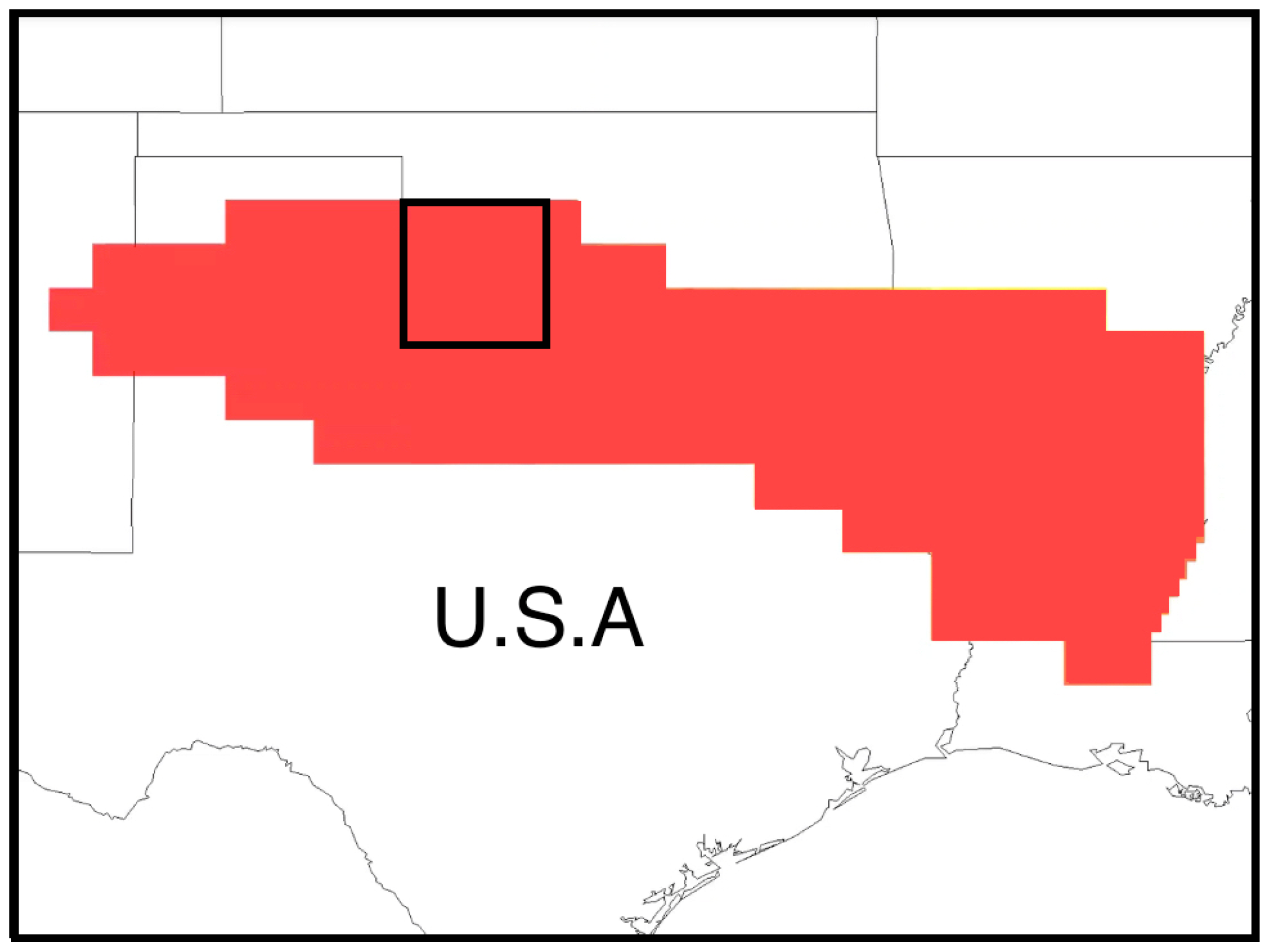
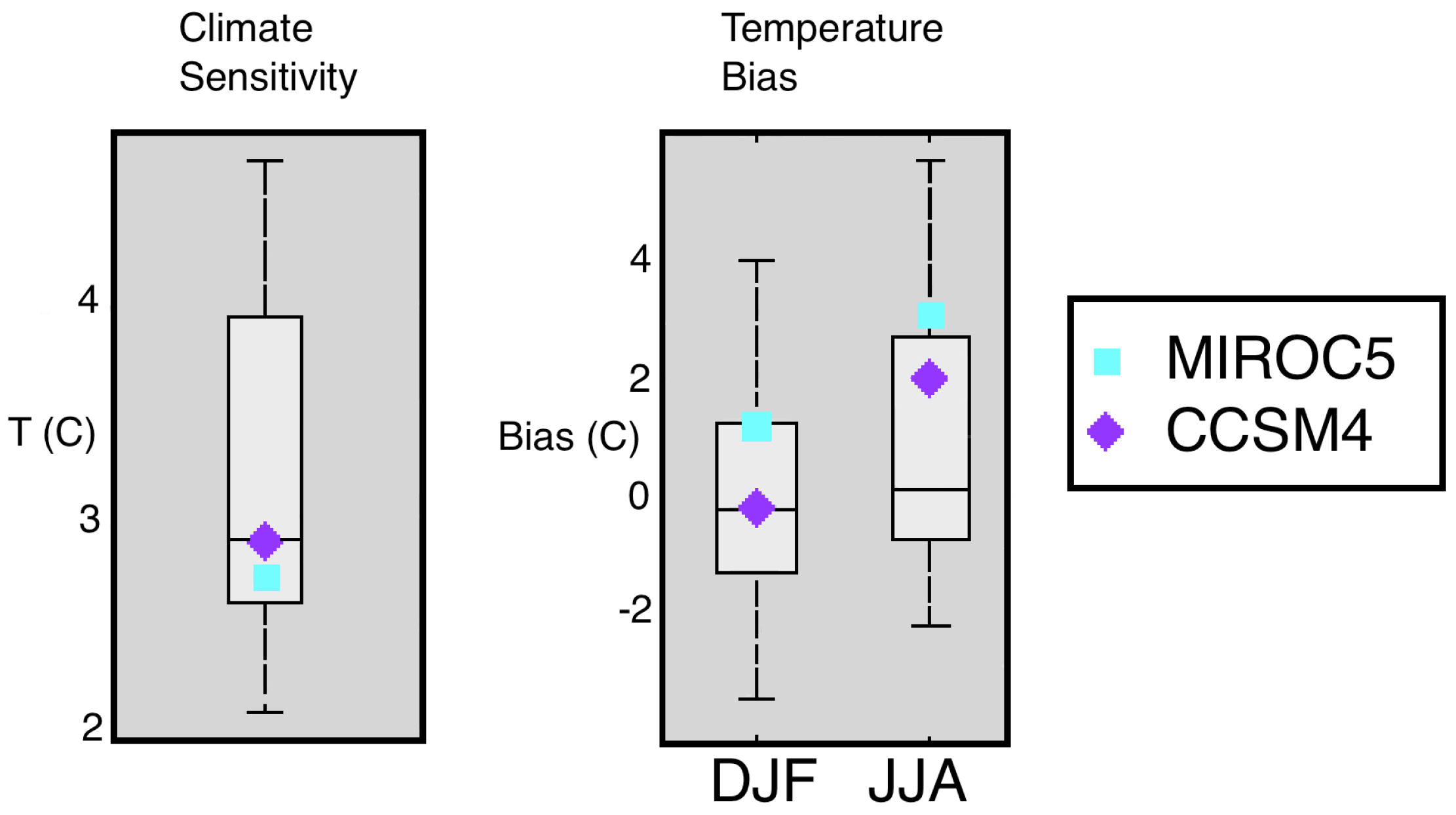
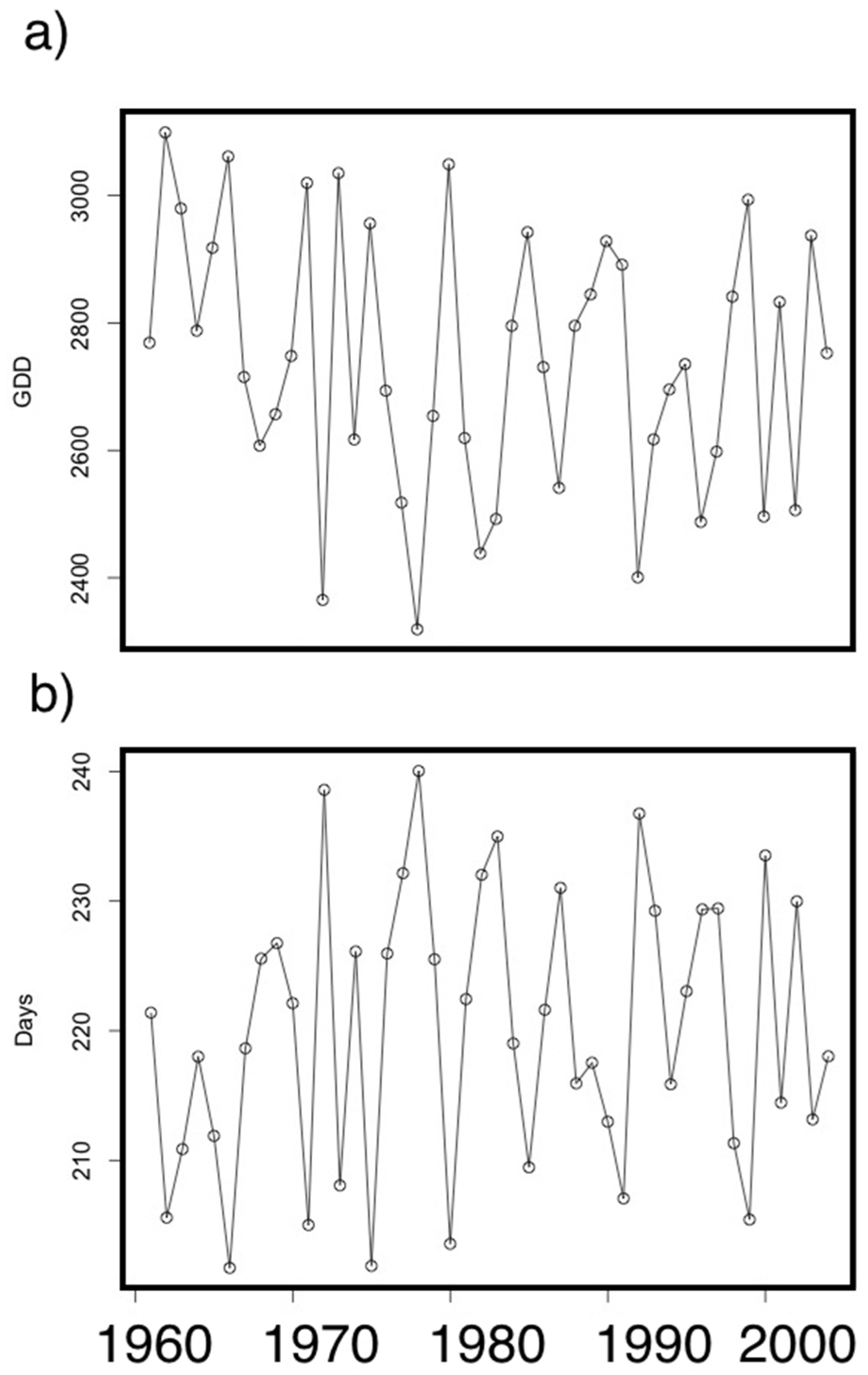
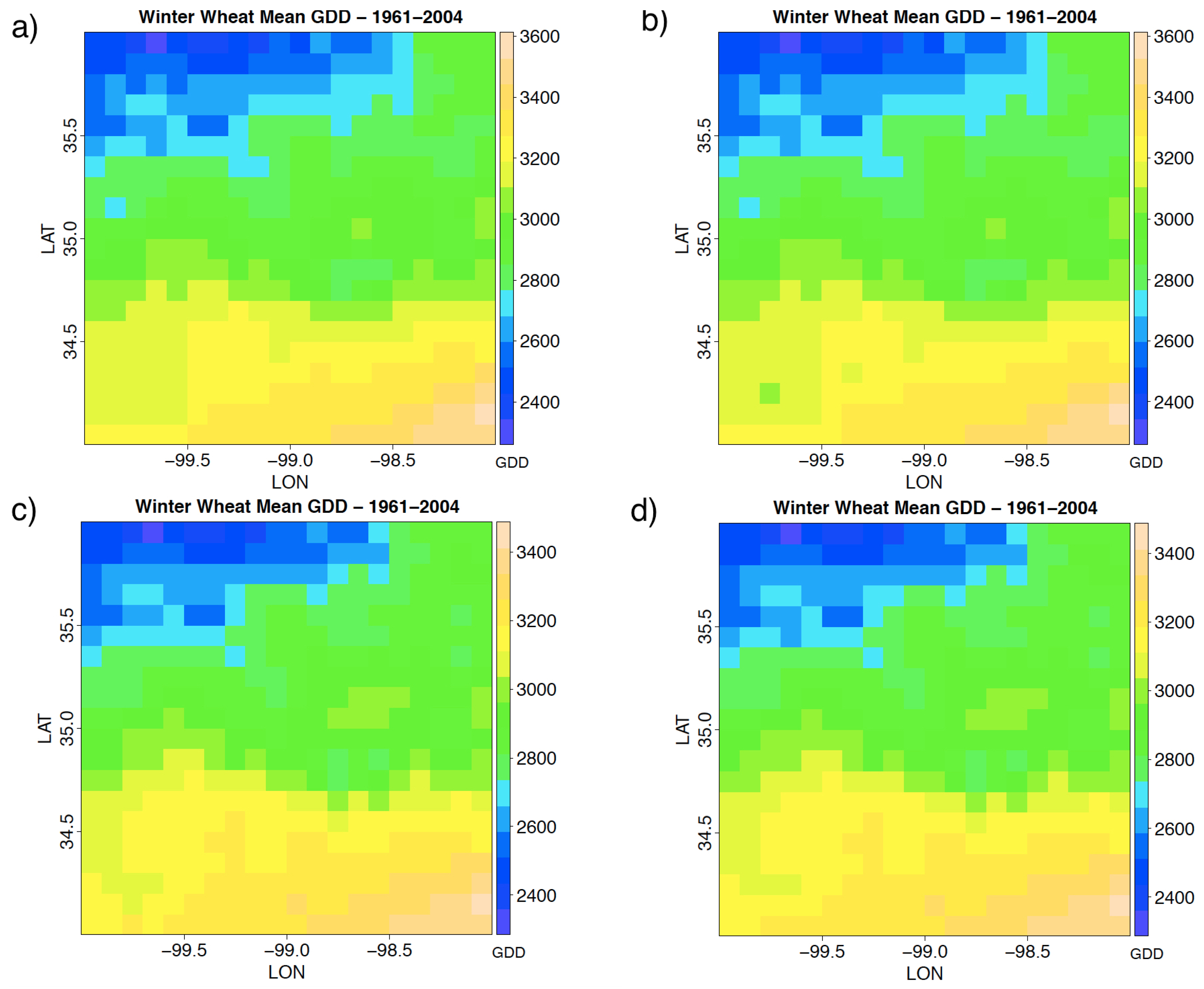
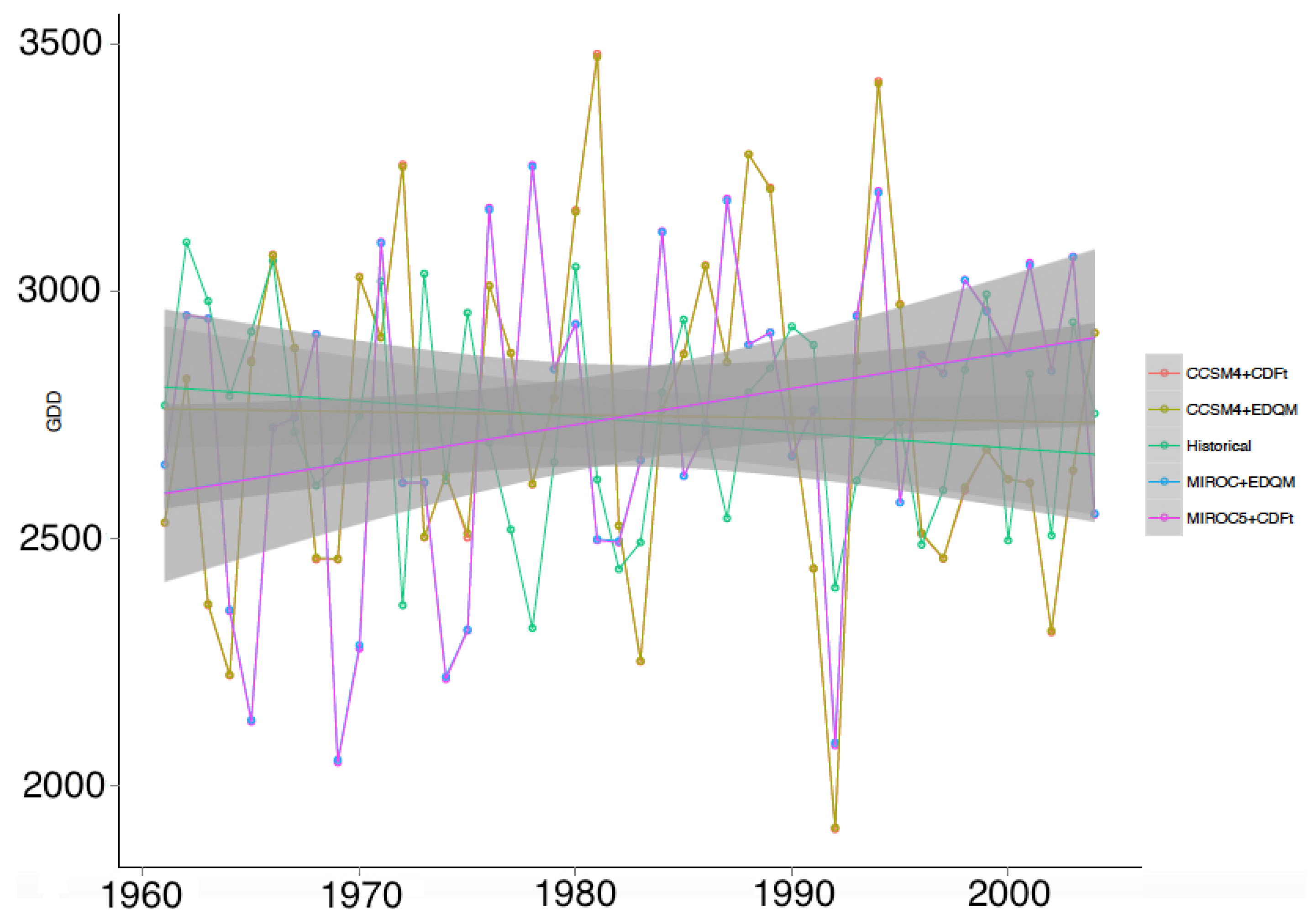
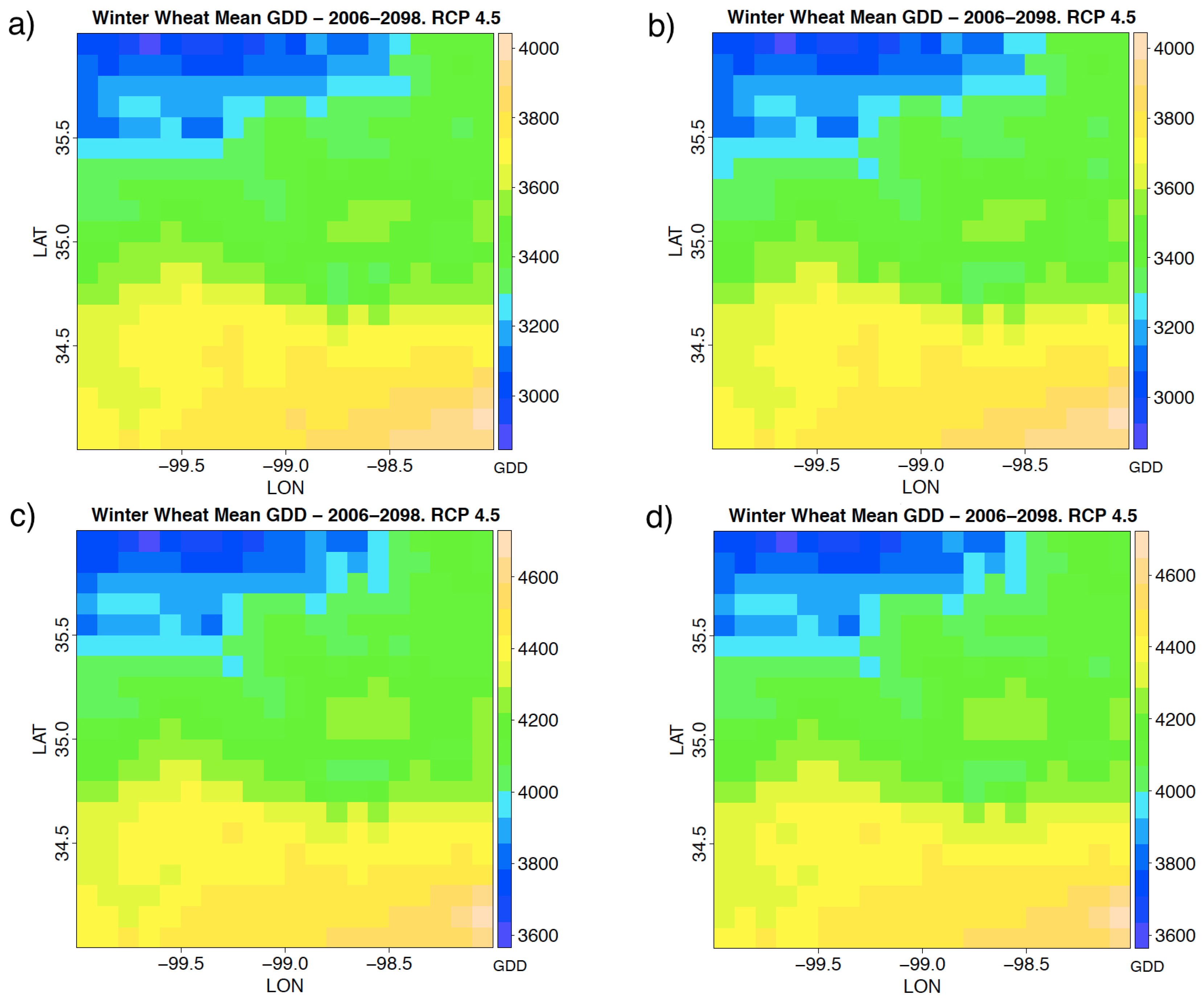
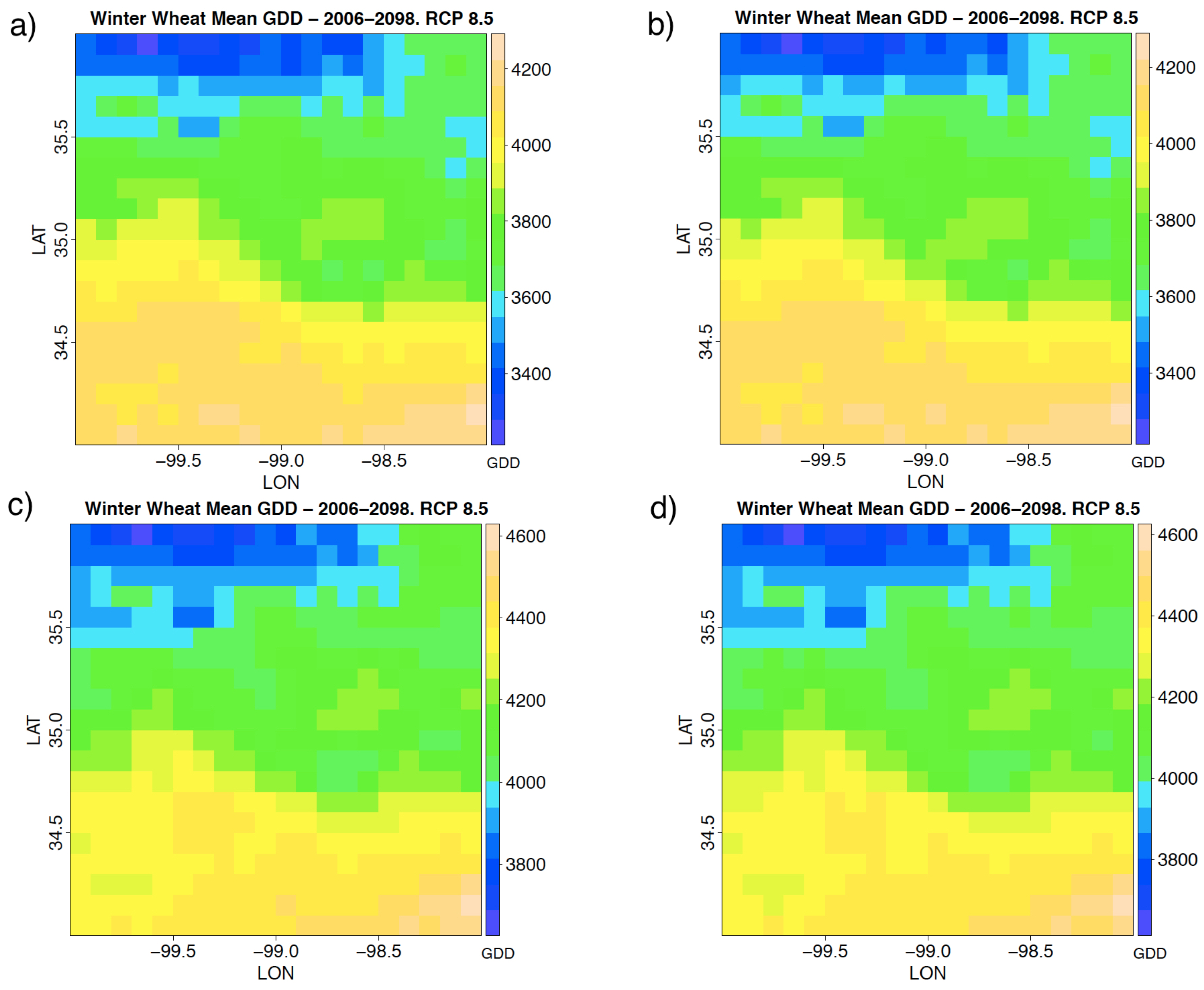
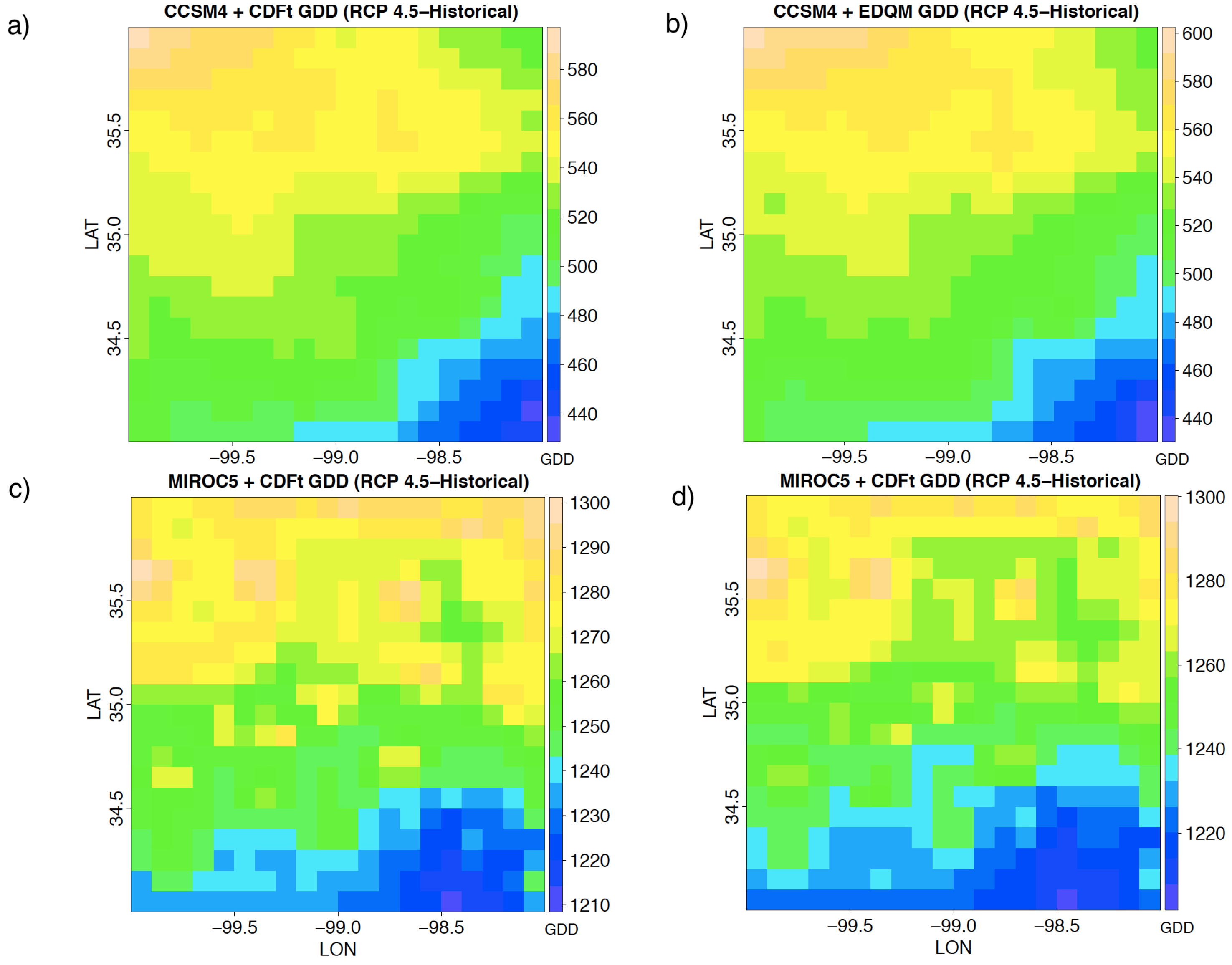
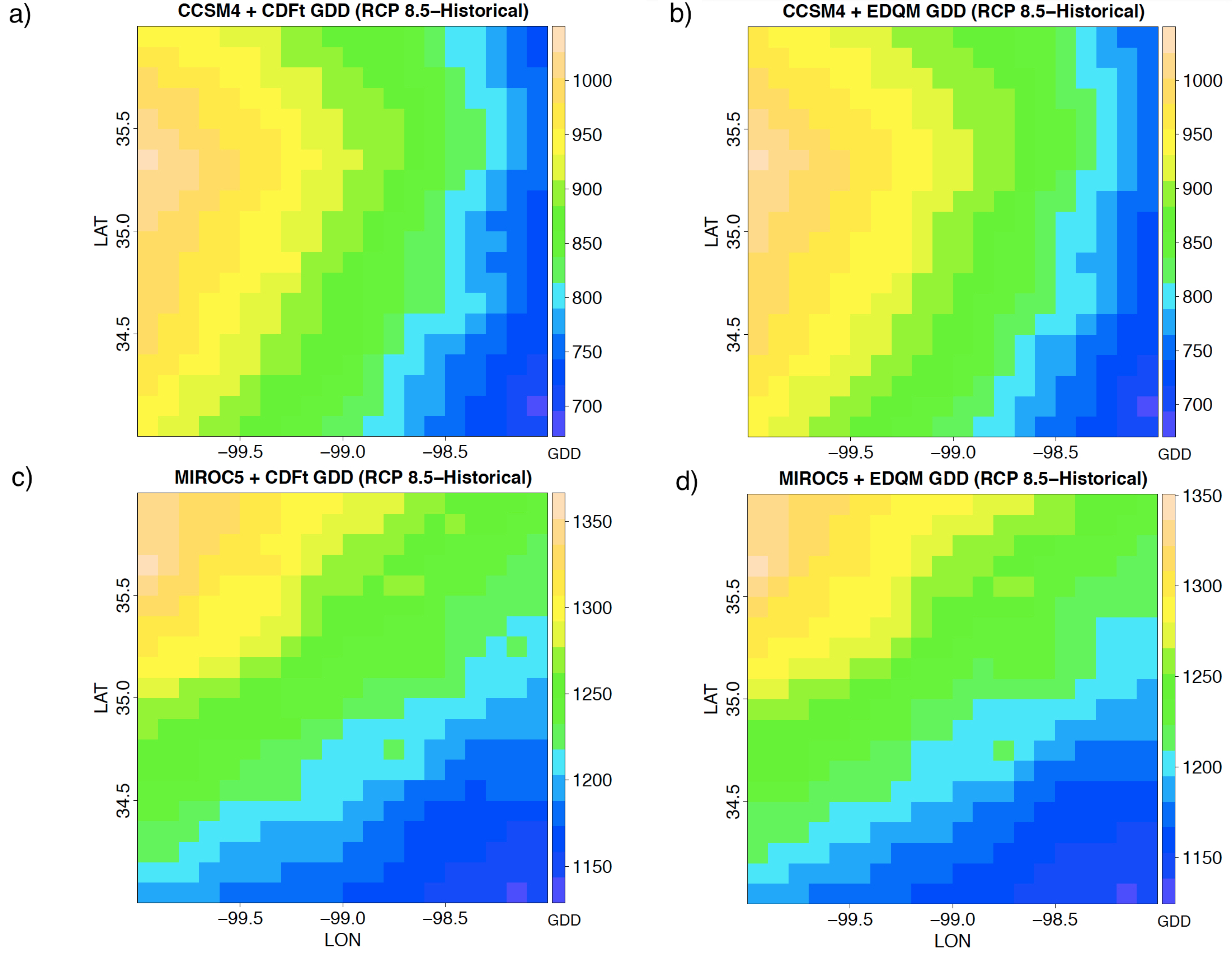
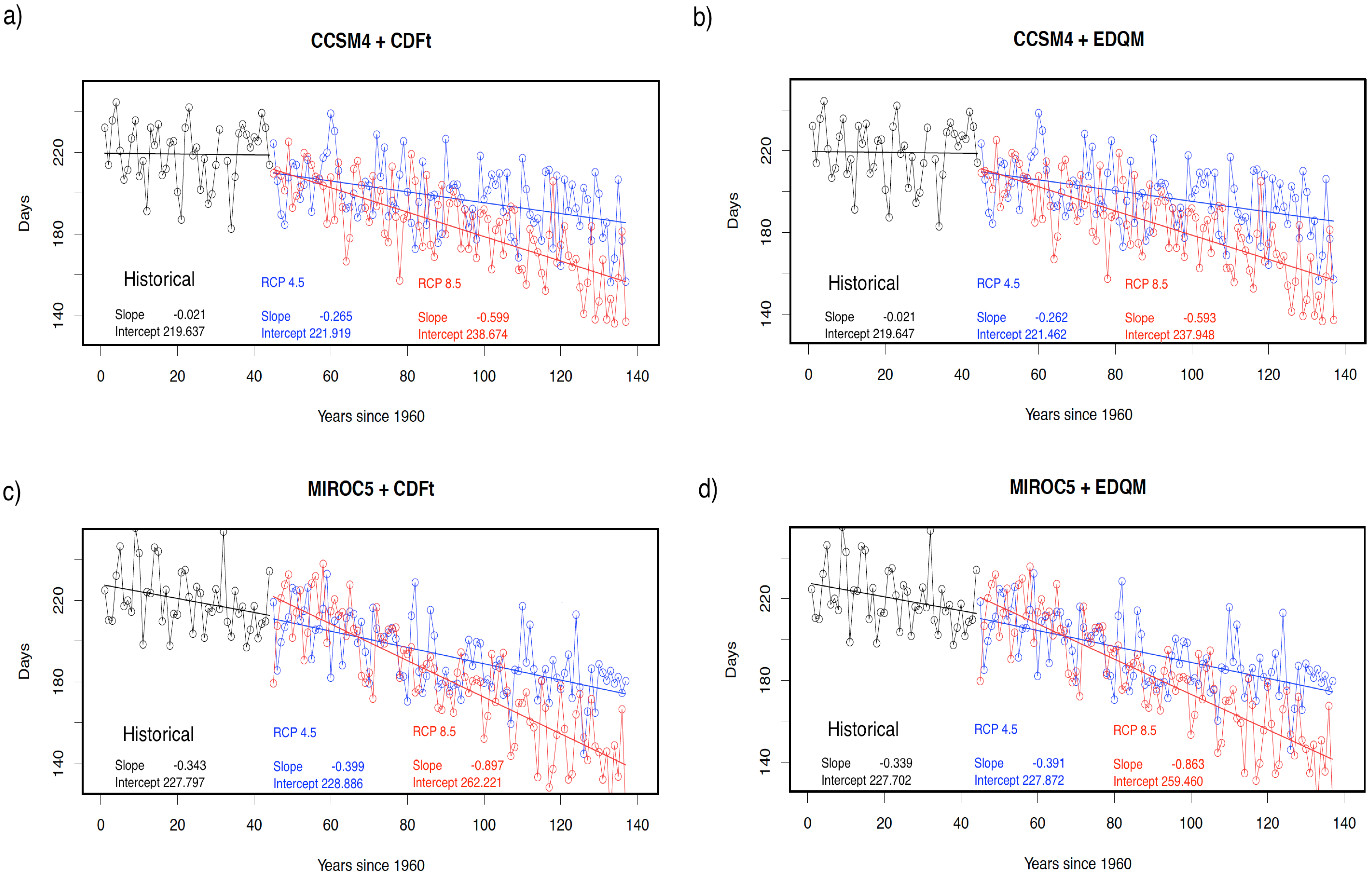
© 2016 by the authors; licensee MDPI, Basel, Switzerland. This article is an open access article distributed under the terms and conditions of the Creative Commons Attribution (CC-BY) license (http://creativecommons.org/licenses/by/4.0/).
Share and Cite
Ruiz Castillo, N.; Gaitán Ospina, C.F. Projecting Future Change in Growing Degree Days for Winter Wheat. Agriculture 2016, 6, 47. https://doi.org/10.3390/agriculture6030047
Ruiz Castillo N, Gaitán Ospina CF. Projecting Future Change in Growing Degree Days for Winter Wheat. Agriculture. 2016; 6(3):47. https://doi.org/10.3390/agriculture6030047
Chicago/Turabian StyleRuiz Castillo, Natalie, and Carlos F. Gaitán Ospina. 2016. "Projecting Future Change in Growing Degree Days for Winter Wheat" Agriculture 6, no. 3: 47. https://doi.org/10.3390/agriculture6030047
APA StyleRuiz Castillo, N., & Gaitán Ospina, C. F. (2016). Projecting Future Change in Growing Degree Days for Winter Wheat. Agriculture, 6(3), 47. https://doi.org/10.3390/agriculture6030047





